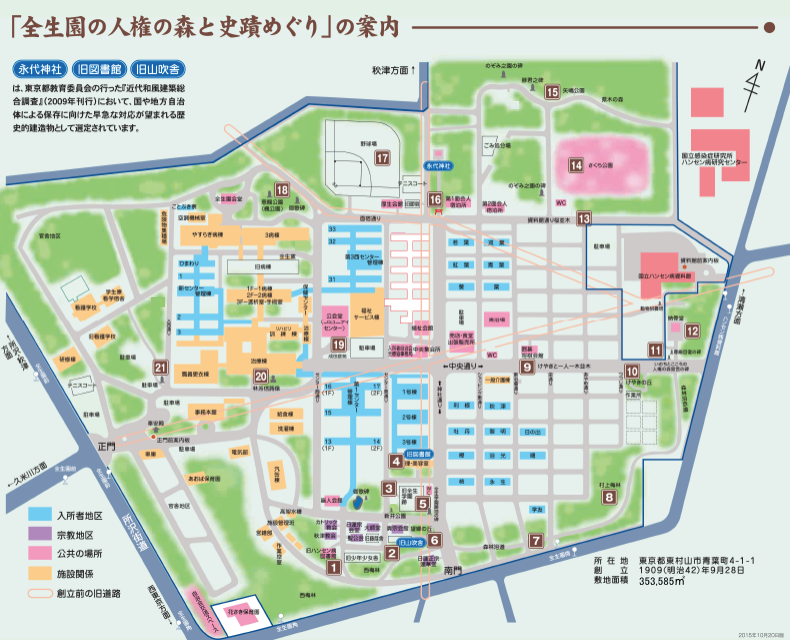Tama Zenshoen Map
- Top
- Visitor Information
- Tama Zenshoen Map
Introduction to Tama Zenshoen
-
Tama Zenshoen was established on September 28, 1909, at the present location as Zensei Hospital Region 1 sanatorium (united prefectural sanatorium for 1 metropolitan area and 6 prefectures of the Kanto region, and prefectures of Niigata, Aichi, Shizuoka, Yamanashi, and Nagano). On July 1, 1941, the sanatorium was transferred to the national government and its name was changed to National Sanatorium Tama Zenshoen. There were 1,221 inmates in 1947. After the All-Japan National Leprosaria Patients' Association (now All-Japan National Hansen's Disease Sanatoria Residents' Association) was formed in 1951, Tama Zenshoen also served as the base for the movement.
Location
-
At the time of its establishment, the sanitorium was located in a thickly wooded area of Musashino on the periphery of Tokyo Prefecture. Together with the former tuberculosis and psychiatric hospital facilities that lined the neighborhood, the sanatorium formed one of the largest hospital districts. Later, a railway station was built, roads were constructed, and with the residential development in the surrounding area, the sanatorium has now become a part of the city center.
Features of Tama Zenshoen
-
Among the sanatoria across Japan, Tama Zenshoen serves as a medical center for the five sanatoria in the eastern part, providing treatment to patients transferred from other sanatoria, artificial dialysis, and outpatient treatment for those who have been rehabilitated to the society. Thanks to the greening campaign by the Resident Association, the sanatorium is full of greenery. In spring, the tunnel of cherry blossoms attracts many local residents. There is a lot of interaction with the local groups of people with disabilities and patients in Higashimurayama City. Currently, the "Jinken-no-Mori (the Forest of Human Rights) Initiative" is being developed, which preserves the abundant greenery and historic buildings in the sanatorium for the community, and more and more visitors from schools and other institutions have been coming and exploring this place.
* Tama Zenshoen is managed by the National Sanatorium Tama Zenshoen.
If you would like to visit Tama Zenshoen in a group with more than 10 people, please contact us in advance.
Contact: Tama Zenshoen General Affairs Division
TEL: 042-395-1101
Hours: Weekdays (Monday-Friday) 8:30 - 17:00

-
 01. Former boys and girls house
01. Former boys and girls house
-
 02. Yamabukisha
02. Yamabukisha
-
 03. Arai Park
03. Arai Park
-
 04. Former library (hairdressing and beauty saloon)
04. Former library (hairdressing and beauty saloon)
-
 05. Site of Zensei Gakuen
05. Site of Zensei Gakuen
-
 06. A Hill of Nostalgia
06. A Hill of Nostalgia
-
 07. Forest bathing path
07. Forest bathing path
-
 08. Murakami Plum Forest
08. Murakami Plum Forest
-
 09. Row of zelkova trees, One-Tree-for-One-Person
09. Row of zelkova trees, One-Tree-for-One-Person
-
 10. Keyaki Hill
10. Keyaki Hill
-
 11. Monument of the Declaration of Jinken-no-Mori for Life and Mind
11. Monument of the Declaration of Jinken-no-Mori for Life and Mind
-
 12. Ossuary
12. Ossuary
-
 13. Row of cherry trees along the Museum Street
13. Row of cherry trees along the Museum Street
-
 14. Sakura Park
14. Sakura Park
-
 15. Yajima Park
15. Yajima Park
-
 16. Nagayo Shrine
16. Nagayo Shrine
-
 17. Baseball field
17. Baseball field
-
 18. Onshi Park (Maple Park)
18. Onshi Park (Maple Park)
-
 19. Narita Teien Garden
19. Narita Teien Garden
-
 20. Bust of Yoshinobu Hayashi
20. Bust of Yoshinobu Hayashi
-
 21. Ohnishi Street
21. Ohnishi Street
-
 01. Former boys and girls house
01. Former boys and girls house
-
 02. Yamabukisha
02. Yamabukisha
-
 03. Arai Park
03. Arai Park
-
 04. Former library (hairdressing and beauty saloon)
04. Former library (hairdressing and beauty saloon)
-
 05. Site of Zensei Gakuen
05. Site of Zensei Gakuen
-
 06. A Hill of Nostalgia
06. A Hill of Nostalgia
-
 07. Forest bathing path
07. Forest bathing path
-
 08. Murakami Plum Forest
08. Murakami Plum Forest
-
 09. Row of zelkova trees, One-Tree-for-One-Person
09. Row of zelkova trees, One-Tree-for-One-Person
-
 10. Keyaki Hill
10. Keyaki Hill
-
 11. Monument of the Declaration of Jinken-no-Mori for Life and Mind
11. Monument of the Declaration of Jinken-no-Mori for Life and Mind
-
 12. Ossuary
12. Ossuary
-
 13. Row of cherry trees along the Museum Street
13. Row of cherry trees along the Museum Street
-
 14. Sakura Park
14. Sakura Park
-
 15. Yajima Park
15. Yajima Park
-
 16. Nagayo Shrine
16. Nagayo Shrine
-
 17. Baseball field
17. Baseball field
-
 18. Onshi Park (Maple Park)
18. Onshi Park (Maple Park)
-
 19. Narita Teien Garden
19. Narita Teien Garden
-
 20. Bust of Yoshinobu Hayashi
20. Bust of Yoshinobu Hayashi
-
 21. Ohnishi Street
21. Ohnishi Street
From the "Jinken-no-Mori and Historic Sites" walking tour at Zenshoen
Edited and published by Tama Zenshoen Resident Association
